The Most Comfortable Freestanding Tub: A Comprehensive Exploration
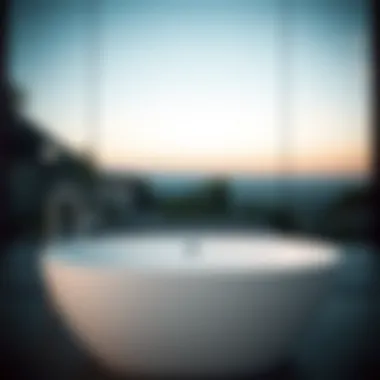
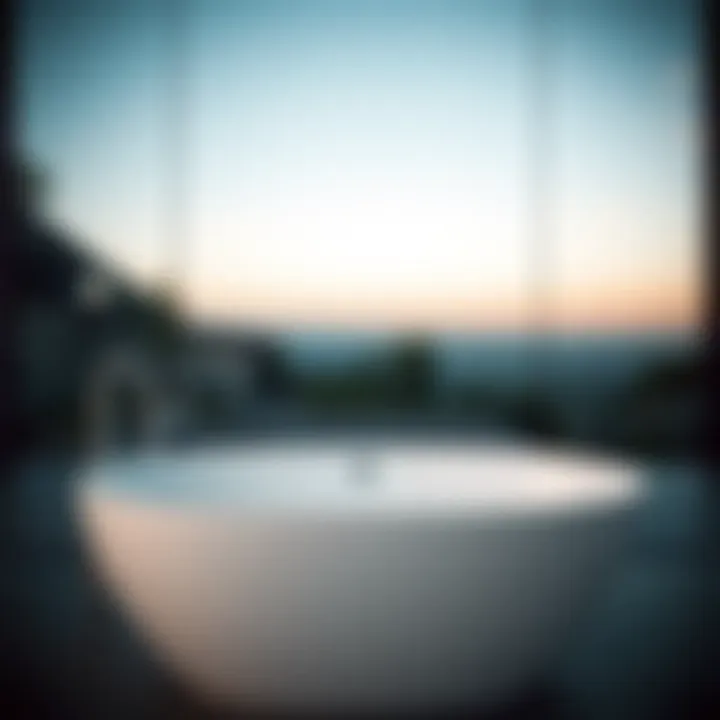
Intro
Freestanding bathtubs have become more than just a place to soak; they are a statement, exuding elegance and comfort in modern bathrooms. For many homeowners and design enthusiasts, selecting the right tub is not just about aesthetics, but also about how it enhances relaxation and overall experience. As you navigate the array of options, it becomes essential to consider various factors that contribute to the comfort and functionality of these tubs.
Did you know that the design, material, and ergonomic features can greatly influence your bath time experience? This exploration will delve into how these elements intermingle, providing a holistic picture of what to look for when choosing the most comfortable freestanding tub. Alongside comfort, we will discuss the practical aspects such as maintenance, costs, and installation—ensuring you are well-equipped to make an informed decision for your home.
From traditional designs to contemporary styles, the choices are overwhelming. Therefore, this guide aims to simplify the process by highlighting key points that define not only comfort but also elegance in bathroom decor. Now, let’s take a closer look at the design inspirations that influence modern freestanding tubs.
Understanding Freestanding Tubs
The growing fascination with freestanding tubs stems from their ability to transform a bathroom into an oasis of relaxation and style. As we embark on this exploration, it's crucial to grasp what freestanding tubs truly represent in today’s home design. Unlike traditional built-in options, they offer flexibility in placement and design, which makes them an attractive choice for homeowners.
Definition and Characteristics
Freestanding tubs are standalone bathtubs that are not attached to any walls, providing a range of advantages that appeal to design aficionados and those seeking comfort. These tubs are available in various shapes and sizes, from sleek modern silhouettes to more classic, rounded forms. A notable characteristic is their versatile installation; they do not require a specific alcove or enclosure, allowing for more creativity in bathroom layouts.
Additionally, these tubs are crafted from a range of materials like acrylic, cast iron, and stone resin, each providing a different aesthetic and feel. For example, acrylic tubs are lightweight and can be easily maneuvered into different spaces, while cast iron models, although heavier, offer exceptional heat retention.
It’s important to prioritize not just the look but also practical aspects like depth and width, as these features significantly affect user comfort.
Historical Context
The concept of the freestanding tub isn't a recent innovation; its origins can be traced back to the luxurious bathtubs of the late 19th and early 20th centuries. During that time, homes displayed an opulent aesthetic, with bathrooms often being designed as personal retreats. The classic clawfoot tub emerged as a staple in many households, representing not just technological advancement in plumbing, but also a symbol of status and comfort.
As we moved into the modern era, shifts in bathroom design reflected changes in lifestyle, with a focus on minimalism and functionality. Despite these shifts, the freestanding tub has seen a resurgence, driven largely by trends favoring open, airy spaces. Today, these tubs are more than just a means to bathe; they represent a pivotal element in the holistic design of a home.
"In understanding freestanding tubs, we appreciate not only the comfort they bring but also how they can redefine bathroom spaces as sanctuaries of relaxation."
As we delve deeper into this comprehensive guide, it becomes evident that understanding freestanding tubs requires recognition of their design, material considerations, and historical significance. Each of these aspects plays a vital role in the tub's contribution to homeowner satisfaction and should be considered carefully when choosing the right fit for any space.
Key Features of Comfort in Freestanding Tubs
When it comes to enjoying a relaxing soak, comfort is king, and freestanding tubs excel in delivering that comfort. This section highlights the critical features that contribute to a comfortable bathing experience. Factors ranging from design and materials to ergonomics shape the overall bliss of unwinding in your tub. The right combination of these elements makes a freestanding bath an oasis of tranquility in your home. Let's break down some of the significant aspects to consider when choosing a freestanding tub.
Shape and Design
Round versus Oval
The shape of a freestanding tub plays a crucial role in comfort. Round tubs often provide a spacious interior, allowing the bather to lounge comfortably without feeling cramped. Their curves can create a gentle hug around the body, making it easy to relax. On the flip side, oval tubs seem to have won the hearts of many homeowners for their elegant aesthetic and practicality. They can fit snugly into various bathroom layouts, giving off a sense of sophistication while still providing ample room for soaking.
In terms of benefits, a round tub can be ideal for those who lean towards a more modern aesthetic, while an oval option might cater to traditional decor. A unique advantage of the oval tub is its versatility in pairing with various styles of faucets and fixtures, which can enhance the overall look of your bathroom.
Modern versus Traditional Styles
Modern and traditional styles cater to different tastes, yet both have their own merits contributing to comfort. Modern designs are typically sleek and streamlined, offering a minimalist approach that promotes tranquility. This style often features materials like acrylic, which are lighter and easier to move. In contrast, traditional tubs made of cast iron or stone resin provide a solid and luxurious feel, often evoking a sense of nostalgia.
A modern tub can be more accessible, easier to maintain, and can come with soaking depth options that enhance comfort. However, traditional tubs utilize heavier materials, which can mean greater durability. That said, if space is a consideration, the more compact designs of modern tubs may be better for smaller bathrooms.
Material Considerations
Acrylic
Acrylic is a popular choice for freestanding tubs, and rightly so. It's lightweight, easy to clean, and retains heat well, making it a good option for those who love long soaks. The smooth surface is not only visually appealing but also prevents bacteria buildup, making maintenance a breeze. Furthermore, acrylic tubs can be molded into various shapes and sizes, allowing greater flexibility in design.
However, one must consider that acrylic can scratch more easily than other materials. While it's generally durable, excessive wear and tear might require more frequent replacements. Despite this, its comfort in terms of warmth and lightweight for installation makes acrylic a favorable choice for many homeowners.
Cast Iron
Cast iron is the heavyweight champion in the world of freestanding tubs. It provides incredible insulation, maintaining the water temperature for extended periods. The stability and durability of cast iron have made it a timeless choice, often associated with luxury. One downside is the weight—these tubs can be quite challenging to install and may require reinforced flooring.
Moreover, while cast iron tubs offer a classic and elegant look, they can come in limited designs compared to acrylic models. The potential for chipping or scratching is another consideration. Nonetheless, the luxury feel and prolonged heat retention certainly add a touch of comfort that many find hard to resist.
Stone Resin
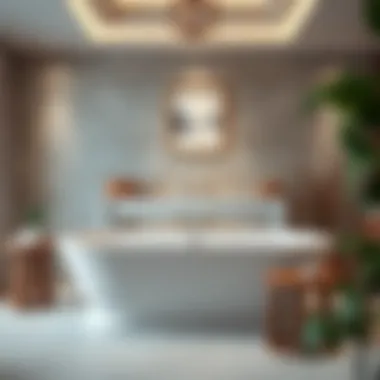
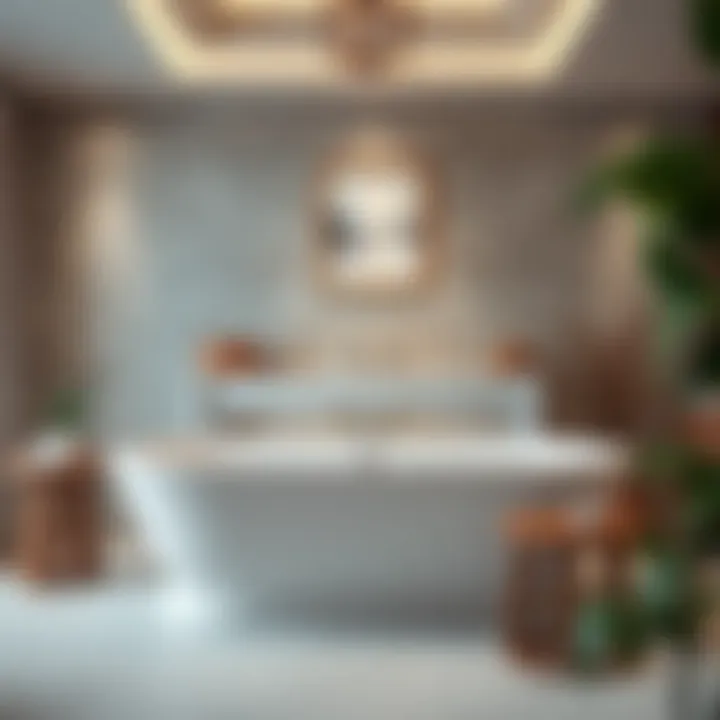
Stone resin tubs present a modern alternative that embodies both beauty and functionality. These tubs boast an attractive finish and are known for their robust feel. They combine resin with stone, which allows them to maintain heat effectively while providing a solid bathing surface that feels comfortable against the skin.
One advantage of stone resin is its resistance to chipping or fading, making it a long-lasting investment. On the downside, they are heavier than acrylic tubs and can also take a bit more time to dry.
Ergonomic Design Elements
When it comes to selecting a freestanding tub, ergonomic design elements play a pivotal role in ensuring a comfortable bathing experience. These features address the natural contours of the human body, allowing for optimal relaxation during a soak. Investing time in understanding these elements not only elevates personal comfort but can also significantly enhance the overall aesthetic of your bathroom.
Back Support
One of the primary elements of ergonomic design is back support. The right angle and support for your back are crucial for enjoyment. Many tubs come with a gently sloped backrest that cradles the back, allowing the bather to recline comfortably. Take the time to consider how this angled design impacts overall comfort.
- Anatomical Contours: Tubs such as those created by companies like Victoria + Albert integrate anatomical shapes tailored for support. The curve should fit snugly against your back, reducing strain and allowing for longer bathing sessions without discomfort.
- User Experience: Feedback from consumers often highlights the importance of back support. Many report that a thoughtful design prevents muscle tension, allowing for relaxation. In contrast, a poorly designed tub can lead to an awkward experience, where users find themselves adjusting frequently to maintain comfort.
Ledge and Armrest Design
Equally important is the ledge and armrest design. A well-designed ledge not only serves functional purposes but also enhances the comfort factor:
- Placement and Height: The height of the ledge is significant. It should be adequately placed to rest arms comfortably, preventing strain during those long, soothing baths. Models like Jacuzzi’s J-425 provide ample ledge space, perfect for setting down a candle or a glass of wine.
- Comfort and Functionality: A padded or contoured armrest can make a world of difference. Armrests that integrate with the overall design allow users to lean back without fatigue, giving an impression of being wrapped in a soft cocoon. The cushioning should not impede the ability to get in and out of the tub safely, putting function on equal footing with comfort.
Rich in detail, the integration of back support and ledge design directly affects the overall comfort of freestanding tubs. With thoughtful design considerations, homeowners can create an inviting space for relaxation that harmonizes both aesthetics and practical features.
"The comfort of a bath isn’t just in warm water; it’s in the design that cradles you, making every soak a retreat from the world." - Design Enthusiast.
By focusing on these ergonomic elements, you nurture a space that embodies tranquility and luxury, elevating the simple act of bathing to an experience of true indulgence.
Comparative Analysis of Popular Models
The world of freestanding tubs introduces a variety of options, each vying for the title of the most comfortable. This comparative analysis serves to dissect popular models, highlighting the subtleties that can greatly influence a consumer’s satisfaction. Making an informed decision about which tub fits your needs means recognizing that comfort goes beyond just aesthetics; it's intertwined with functional features and quality materials.
For homeowners, interior design enthusiasts, and anyone invested in crafting a luxurious bath experience, understanding the distinct characteristics of various models is vital. Knowing the differences between high-end, luxury brands and more economical choices helps clarify what to expect within each price range, as it reflects on material quality, design integrity, and long-lasting comfort.
Identifying the key benefits and considerations—like user experience, warranty provisions, and brand reputation—can steer your path toward selecting a tub that meets both budget constraints and luxurious aspirations.
Luxury Brands
When delving into luxury brand freestanding tubs, it's not simply about splurging; it's about investing in craftsmanship. Brands such as Waterworks or Soaking Tubs consistently push the envelope on comfort, marrying innovative technology with traditional craftsmanship. These models often showcase unique features, ergonomic designs, and premium materials that elevate the soaking experience.
- High-Quality Materials: Many luxury freestanding tubs utilize materials like acrylic and stone resin, known for their durability and heat retention. This translates to a longer-lasting product that keeps your bath warmer for more extended periods.
- Design Innovations: A standout feature of luxury brands is their design elegance. Brands like Victoria + Albert offer tubs that are as beautiful as they are functional, often available in various colors and finishes to fit different home styles.
- Enhanced Ergonomics: Models from Kohler or Duravit tend to have superior ergonomic features, integrating backrest contours that mold to the body, providing not just comfort but a cocoon-like escape.
Investing in these luxury freestanding tubs means embracing a bath that not only complements your decor but also caters to personal comfort in an unparalleled way. Buying from established manufacturers also typically includes warranties that provide peace of mind, which can justify the higher price tag in many cases.
Budget-Friendly Options
On the other end of the spectrum are budget-friendly freestanding tub options, which prove that comfort does not have to come at a high price. Brands like American Standard and Mellow offer models that prioritize comfort while ensuring affordability. These tubs can still provide an impressive soaking experience and fit neatly into most budgets.
- Cost-Effective Materials: While not always using premium materials, budget options often employ practical substitutes that offer good durability and ease of maintenance. Acrylic and fiberglass can not only be lightweight but also pleasing to the eye.
- Basic Ergonomic Features: Many budget models incorporate essential ergonomic considerations, such as sloped backs and inviting ledges, at a fraction of the cost. While they may not boast some high-end features, they still offer a respectable level of comfort.
- Accessibility: With affordability comes increased accessibility. These tubs have become a popular choice in renovation projects for homeowners looking to enhance their space without breaking the bank.
When evaluating budget-friendly options, consumer reviews and feedback can offer invaluable insight. They help identify which models provide the best value for your money and contribute to understanding customer satisfaction levels. This can ultimately guide you toward the most comfortable model within your price range.
In essence, whether seeking high-end luxury or more attainable solutions, a thorough exploration of popular models allows for a well-rounded understanding of what defines comfort in the realm of freestanding tubs. Choosing wisely not only elevates your bathing experience but also transforms your bathroom into a retreat that offers both functionality and relaxation.
"The right freestanding tub can turn an ordinary bathroom into a personal haven."
For further reading on the history and evolution of freestanding tubs, consider checking Encyclopedia Britannica or discussions around this topic on Reddit.
In the next section, we will explore installation considerations to ensure that your selected model not only fits your aesthetic but also aligns with your practical needs.
Installation Considerations
When it comes to installing a freestanding tub, there are a multitude of factors at play that must be thoroughly assessed. This isn’t a mere decision about aesthetic appeal; it's a process that intertwines practicality and artistry. The beauty of a freestanding tub can be overshadowed by installation blunders if one's not careful, hence why grasping the nuances of installation is essential. Let's dive deeper into the two pivotal elements that must be considered: plumbing requirements and space requirements.
Plumbing Requirements
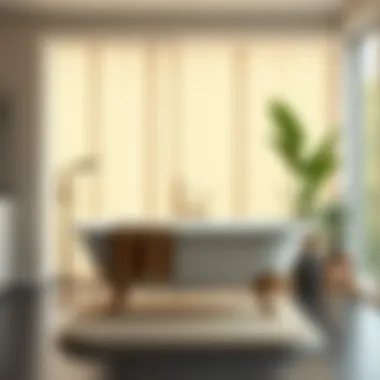
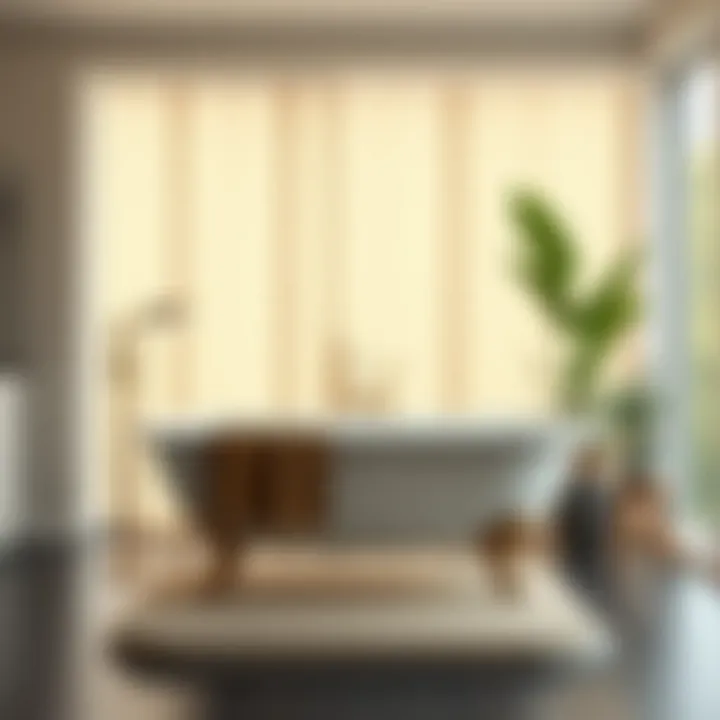
Proper plumbing is the lifeblood of any freestanding tub setup. It’s imperative to ensure that the necessary plumbing infrastructure is in place before you get excited about the soaking sessions ahead. A number of aspects need to be factored in:
- Water Supply and Drainage: Freestanding tubs require dedicated supply lines and a robust drainage system. It’s crucial they’re compatible with the tub’s specifications. Not all tubs have standard connections, so double-check before making a purchase.
- Location of Plumbing: The ideal location is often where the existing plumbing allows for a seamless setup. If it’s a retrofit installation, you might face complications that could drive up costs if plumbing has to be relocated or modified.
- Water Pressure: Ensure the water pressure in your home meets the requirements of the tub. Some freestanding tubs necessitate higher pressure for optimal performance, which could mean adjustments if your home has low water pressure.
- Material Compatibility: Various tub materials have different plumbing needs. For instance, a cast iron tub is heavier and might require sturdier piping compared to lighter acrylic options.
Taking the time to address these plumbing considerations could save a homeowner from costly future repairs or renovations. Properly installed plumbing not only fosters functionality but also enhances the enjoyment of your beautiful freestanding tub.
Space Requirements
Once the plumbing is sorted out, it's time to consider space. Installing a freestanding tub is not always as simple as plopping it on the bathroom floor. Ensure you take these space requirements into account:
- Room Dimensions: Measure your bathroom meticulously. A tub that looks quaint in a showroom might feel oversized in your home.
- Accessibility: Leave a reasonable amount of space around the tub for ease of entry and exit. Nothing’s worse than feeling cramped and confined while trying to relax.
- Floor Load: Freestanding tubs can be rather weighty, especially when filled. Assess your floor load—older homes may not handle that as well as modern builds, which can lead to complications.
- Aesthetic Integration: Consider how the tub fits into your overall bathroom layout. The size and placement can greatly affect the overall flow and visual appeal of the space.
Taking the time to carefully evaluate these installation aspects not only guarantees a satisfying initial setup but can prevent future woes.
"Proper installation is not just about fitting a tub; it's making sure that every element works in harmony with the space."
Being meticulous about plumbing and space requirements lays the groundwork for all the relaxation and enjoyment you will derive from your luxurious freestanding tub. For further insights and tips on home design, check out resources such as Wikipedia or Reddit's Home Improvement Community.
These careful considerations during the installation phase are paramount in creating an oasis that combines both style and comfort.
Maintenance and Care
Maintaining a freestanding tub requires attention to both cleanliness and durability to ensure it serves its purpose effectively and retains its beauty over time. The right maintenance not only prolongs the life of the tub but also enhances the overall bathing experience. It’s easy to overlook these aspects until that first scratch appears or a stubborn stain mars the surface. Homeowners and design aficionados alike must recognize that in the realm of luxury — a beautiful tub needs a little TLC to keep it looking splendid.
Cleaning Materials
When it comes to cleaning a freestanding tub, selecting the appropriate materials is paramount. Here are some recommendations that cater to various tub materials:
- Soft Cloths or Sponges: For general cleaning, avoid rough materials that can scratch your tub. Soft cloths work wonders on acrylic or cast iron tubs.
- Mild Detergents: Instead of harsh chemicals, mild dish soap diluted in warm water can effectively remove everyday grime. However, always ensure that the chosen detergent is suitable for the tub material. Some ingredients can cause discoloration, especially in stone resin tubs.
- Baking Soda: This versatile powder can provide a gentle abrasive for tougher spots. Just sprinkle it on, add a bit of water to make a paste, and gently scrub. It’s a great option for tough stain removals without the risk of scratching.
- Vinegar Solution: A blend of vinegar and water can help eliminate mineral deposits, especially in areas with hard water. However, avoid using it on marble finishes as it can dull the surface.
Changing cleaning patterns can catch your eye too. For instance, alternating between different cleaning methods allows for effective stain removal while also providing a refreshing change that can prevent wear over time.
Durability and Long-Term Care
Ensuring a freestanding tub maintains its charm and functionality hinges on understanding its durability. Different materials behave in distinct ways as they age.
- Acrylic Tubs are often touted for their low maintenance and resilience. They are lightweight and can resist chipping and cracking. However, they can be prone to scratching, so keeping them clean and using only soft cleaning materials is important.
- Cast Iron tubs present unparalleled durability. Their enamel finish can withstand a lot, but over time, it may chip due to heavy impacts. Proper protection and avoiding slamming items on the edge can help maintain its structure.
- Stone Resin blends the aesthetics of natural stone and sturdiness, but it requires a bit more care. Regular conditioning with a suitable sealant can help prevent staining and enhance the surface's life.
Moreover, temperature fluctuations can also affect materials, particularly if the tub is placed near windows or drafty areas. Taking the time to seasonally verify that the foundation and fittings are secure ensures that everything stays in tip-top shape, avoiding unforeseen repairs.
"A little constant care goes a long way. Treat your freestanding tub well, and it will reward you with comfort and beauty for years to come."
Overall, understanding the importance of cleaning materials alongside long-term care measures equips homeowners to sustain the elegance and functionality of their freestanding tubs. Investing time and appropriate resources into maintenance paves the way for a welcoming bathing sanctuary.
Cost Implications
The choice of a freestanding tub stretches beyond mere aesthetics or comfort. One cannot underestimate the weight of cost implications when considering this investment. The financial commitment varies across the board, but understanding these implications is critical in making a well-informed decision. It’s not just about the purchase price; ongoing expenses need careful examination as well.
Initial Investment
The initial investment for a freestanding tub can be quite extensive, depending on several factors. First off, brands like Victoria + Albert or Kohler command a premium due to their design and craftsmanship. To put a number on it, a good quality acrylic tub might start around $1,000, but a heavier cast iron option can easily push you over the $3,000 mark.
An important thing to remember is that these costs often don't include installation. Installation expenses can vary significantly based on your existing plumbing and flooring. If you need to do any renovations, those costs can spiral, leading to the disappointment of an unexpectedly large bill. It’s advisable to anticipate these extra costs, as they can often exceed the price tag of the tub itself. The total can tip easily from a couple thousand to substantially larger sums if one is not careful about budgeting and planning.
Long-Term Value
When delving into long-term value, you have to weigh the initial cost against the benefits it brings over time. Higher-end materials usually ensure not just a longer lifespan but also maintenance benefits. For instance, tubs made from stone resin are noted for resisting wear and tear while offering an elegant look. On average, they can last for decades, making them a wise investment for homeowners.
Moreover, a comfortable freestanding tub can increase the resale value of your home. Homebuyers are often wowed by luxurious baths, as they signify a house that has been well-cared for and offers unique amenities. In contrast, cheaper options may end up demanding more in repairs and replacements down the line, lowering your home’s appeal.
"Investing in quality now can save you more in the long run, not just in terms of repairs but also in the enjoyment you’ll get from your tub."
In summary, while the immediate price may raise eyebrows, a freestanding tub is not just a purchase; it’s an investment that, if chosen wisely, pays off in comfort, longevity, and even potential home value increase. By analyzing both initial investments and long-term value, you can find the balance between cost and quality, ensuring a dignified and enriching bathing experience for years to come.


Aesthetic Integration into Interior Design
When homeowners choose a freestanding tub, aesthetics play a significant role in their decision-making process. The way a tub aligns with the overall design of the bathroom can elevate not only the space's beauty but also its functionality. A thoughtfully chosen tub enhances the room's aesthetic appeal, bridging the gap between luxury and everyday use. The integration of these pieces should not be an afterthought; rather, it serves as a critical aspect that ties together the entire ambiance of the room.
Harmonizing with Bathroom écor
It’s essential for a freestanding tub to harmonize with existing bathroom decor. The visual elements, like color schemes and materials used, should echo in the design of the tub. For example, if your bathroom boasts a minimalist aesthetic with clean lines and neutral colors, a sleek, modern tub made from materials like acrylic or stone resin would be appropriate. A contrasting piece, such as an ornate, vintage-inspired tub, could disrupt the harmony, potentially making the space feel disjointed.
Consider the following:
- Materials and Textures: If your bathroom utilizes natural materials like wood or stone, opt for a tub that complements these elements. A matte finish on a tub may resonate well with a textured wall, creating a seamless flow.
- Color Palette: Choose colors within the same family or contrasting shades to make a statement without clashing. For instance, a soft white tub can brighten a dark, moody space, while a darker tub can provide a grounded anchor if the walls are light.
- Style Cohesion: Align the tub’s design with other permanent features in the bathroom. A modern tub pairs well with sleek faucets, while a vintage tub could be accentuated with brass fixtures.
"The key to success in bathroom design lies in the synergy between each element. A tub should feel like part of the whole rather than an isolated feature."
Complementary Fixtures and Accessories
Accessories and fixtures can enhance the visual narrative created by the freestanding tub. When strategically selected, these elements can amplify the tub's presence in the space, making it a true centerpiece.
- Faucets and Showerheads: Selecting fixtures that match the style of the tub is vital. For contemporary designs, sleek lines and minimalist shapes work best. Alternatively, vintage types with intricate details can add sophistication and charm to a traditional setup.
- Towel Racks and Storage: Consider integrating towel racks or shelves that complement the tub's design. A streamlined rack that mirrors the tub's curves can effectively unify the look while serving strategic purposes.
- Lighting: Lighting can dramatically shift the perception of space. Using pendant lights or sconces that echo the materials or style of the tub can create an inviting ambiance. Options like soft yellow light can make a tub feel warm and welcoming, while bright white light enhances a clean, modern look.
- Decorative Touches: Finally, don’t overlook the charm of small decor accents like candles, plants, or decorative trays. These additions can soften the hard edges of a tub, making it feel more integrated into the living space.
User Experiences and Feedback
Understanding the experiences of those who've recently bought or spent time in freestanding tubs is a pivotal aspect in determining what makes a tub truly comfortable. User feedback offers invaluable insights that can guide potential buyers in making informed decisions. These reviews not only highlight individual preferences but also reflect broader trends that can influence purchasing choices. The emotional and practical aspects of user experiences help frame the comfort equation and can dictate how well a tub fits into one’s lifestyle.
Consumer Reviews
When delving into consumer reviews, it’s crucial to sift through the myriad of opinions to find common threads. Many users rave about how certain designs can transform bath time into a spa-like experience. Characteristics like deep soaking options or wide ledges for placing bath essentials can significantly enhance relaxation. For example, it’s not just the aesthetics that sway buyers; comfort tends to come from how users feel enveloped by the tub’s contours.
Some consumers mention a desire for the tub materials used. Acrylic tubs often receive high marks for warmth, while cast iron options win praise for their impressive insulation. However, those navigating small bathrooms may find dimensions equally important, reflecting the necessity of balancing functionality with comfort. A few buyers have specifically pointed out the challenges of installation and upkeep as potential mitigating factors in their overall satisfaction.
- Deep soaking capability often cited in positive reviews.
- Users express a strong preference for materials that provide warmth.
- Concerns about size and space highlight the importance of compatibility with existing bathroom layouts.
Expert Opinions
Expert reviews lend credibility to user experiences, offering a professional perspective on comfort features. Designers and bathroom specialists often underscore the significance of ergonomic shapes and back support. Their insights typically focus on how various design elements, such as integrated armrests and sloped backs, can significantly enhance the experience of soaking.
"Finding a tub that marries aesthetics with functionality is key. A freestanding tub should not just look good; it should make the user feel cradled and supported," notes a prominent bathroom designer in an interview at Britannica.
Furthermore, experts frequently note changing trends in consumer preferences, with a growing demand for more sustainable materials and water-saving designs. They emphasize that, as environmental awareness rises, consumers are likely to favor tubs that meld luxury with eco-conscious features.
To sum it up, while consumer reviews provide a snapshot of personal experiences, expert insights offer a more holistic view of the evolving landscape of freestanding tubs. Combining both perspectives allows potential buyers to grasp the intricate nuances that contribute to ultimate comfort.
For further detailed commentary on this topic, check out community opinions on platforms like Reddit or browse through detailed articles on sites such as Wikipedia.
By closely examining user feedback alongside expert analysis, one can better comprehend what makes a freestanding tub not only a functional addition to the home but also a sanctuary for relaxation.
Future Trends in Freestanding Tub Design
As the world of interior design evolves, freestanding tubs are no longer just luxurious additions; they are becoming smartly designed essentials that reflect shifts in both aesthetic preferences and practical needs. This section highlights the importance of keeping an eye on future trends in freestanding tub design. The movement towards sustainability, innovative features, and other design diversifications not only enhance comfort but also promote a mindful approach to home improvement. It’s these elements that help homeowners and design aficionados pick the right tub for their spaces.
Sustainability Practices
Amid rising awareness about environmental issues, sustainability has become a key player in the design landscape—freestanding tubs included. Here are a few ways sustainability is making its mark:
- Eco-Friendly Materials: Modern tubs are increasingly crafted from recycled materials or those that require less energy to produce. Stone resin, for instance, offers solid durability while minimizing ecological footprints. Homeowners are encouraged to explore options that boast low harmful emissions, contributing positively to indoor air quality.
- Water Efficiency: After all, a comfy soak shouldn’t translate to excessive water use. Brands today focus on conservation features. Some tubs come with built-in flow restrictors, allowing for thoughtful water consumption without compromising the bathing experience. This move not only helps your water bill but is also beneficial to the environment.
"By choosing a sustainable freestanding tub, you aren’t just investing in your comfort; you’re also taking a stand for the planet."
- Production Processes: The journey of the tub doesn't end at material selection. More manufacturers are evaluating their production methods, opting for practices that reduce waste and carbon emissions. Knowing the story behind the tub can help homeowners make informed decisions.
Sustainability is becoming less of a buzzword and more of a necessity. By understanding these considerations, buyers can choose products that align with their values.
Innovative Features
Innovation in freestanding tub design goes hand in hand with comfort and convenience. It's not just about soaking anymore; here are several innovative features shaping the landscape:
- Smart Technology: Some modern tubs are incorporating technology that allows users to control temperature, jets, and even lighting via smartphones. Imagine sinking into a warm bath, while the ambiance is set just how you like it—all with a few taps on your device.
- Built-in Speakers: The appeal of a good playlist is undeniable, and freestanding tubs are embracing this trend. Many models now offer Bluetooth-enabled speakers, which let you enjoy your favorite tunes while you unwind after a long day.
- Hydrotherapy Options: As wellness becomes a priority, tubs that provide hydrotherapy features like adjustable jets for massage are gaining popularity. Such options cater to the more health-conscious consumer, offering therapeutic benefits right at home.
- Integration with Nature: Some designs include features that facilitate an outdoor experience; think of bathtubs gracefully blending with natural surroundings, with an open concept allowing for breathtaking views. Imagine relaxing in a tub while surrounded by calming elements of nature—truly a retreat at home.
In summary, future trends in freestanding tub design are forging paths we never thought possible. By blending comfort with sustainability and technology, these developments illustrate an exciting time for homeowners who value both luxury and responsible living.



